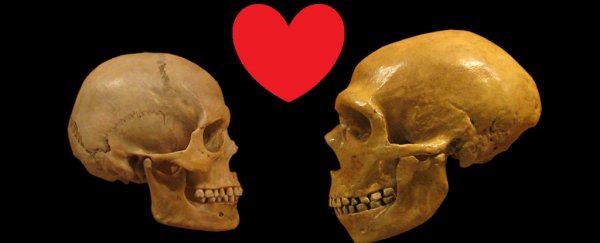Most modern humans have a little bit of Neanderthal hiding somewhere in their genes. For years, it was assumed that this tiny dose of DNA came from a brief encounter between our ancestors and their Neanderthal neighbours thousands of years ago.
But what started as a one night stand now looks more like a frequent love affair. A fresh analysis of the modern human genome suggests that our ancestors did the deed with their Neanderthal cousins more than a few times throughout their shared history.
It's the classic on-again off-again relationship - but on an epic timescale. As early humans made their way out of Africa and into Europe and Asia, they stumbled upon their first Neanderthals. And when two sexually compatible beings live side by side for approximately 30,000 years, a little hanky panky is bound to happen.
Today, most people have about two percent Neanderthal DNA, a reminder of our ancestors' sexual proclivities. In fact, the only people who don't have some Neanderthal DNA are those whose ancestors stayed in Africa, never to frolic with their northern neighbours.
Recently, however, scientists have been taking a closer look at the human genome, and they've noticed something curious about the Neanderthal DNA in particular. It appears that people in East Asia have Neanderthal DNA that is 12 to 20 percent higher than in people of strictly European descent.
This discovery opened up a new possibility. Instead of coming together just once, Neanderthals and modern humans may have reproduced at multiple times throughout their shared history. The explanation fit, but the research was lacking.
With this in mind, two researchers from Temple University decided to pursue a few different research avenues.
Using a large dataset of modern human genomes, the researchers compared the patterns of Neanderthal DNA in people of East Asian and European ancestry. The results confirmed that both of these groups had early multiple mating events with Neanderthals.
The researchers then used a machine-learning algorithm to come up with all the cross-breeding events that could have led to the patterns of Neanderthal DNA they were seeing.
The best models did not fit the idea that Neanderthals and modern humans had only a single episode of cross-breeding.
Instead, the relationship between our ancestors and their Neanderthal cousins appears more complex than we appreciated. The findings suggest there were frequent interactions between the two groups, and it is highly likely that there were multiple sexual encounters between Neanderthals and prehistoric humans in Europe and East Asia.
"Thus, we believe that a probable explanation for our results is that gene flow between humans and Neanderthals was intermittent and ongoing, but in a somewhat geographically restricted region," the authors conclude.
Understanding the different percentages of Neanderthal DNA can offer us a glimpse back into ancient human history. These discrepancies can tell us a lot about how long certain populations co-existed with Neanderthals compared to others.
They also indicate just how closely related modern humans are to Neanderthals - something that scientists have long argued over.
If we want to know more about the complex history between Neanderthals and modern humans, scientists will just have to dive even deeper into the human genome.
This study has been published in Nature Ecology & Evolution.
